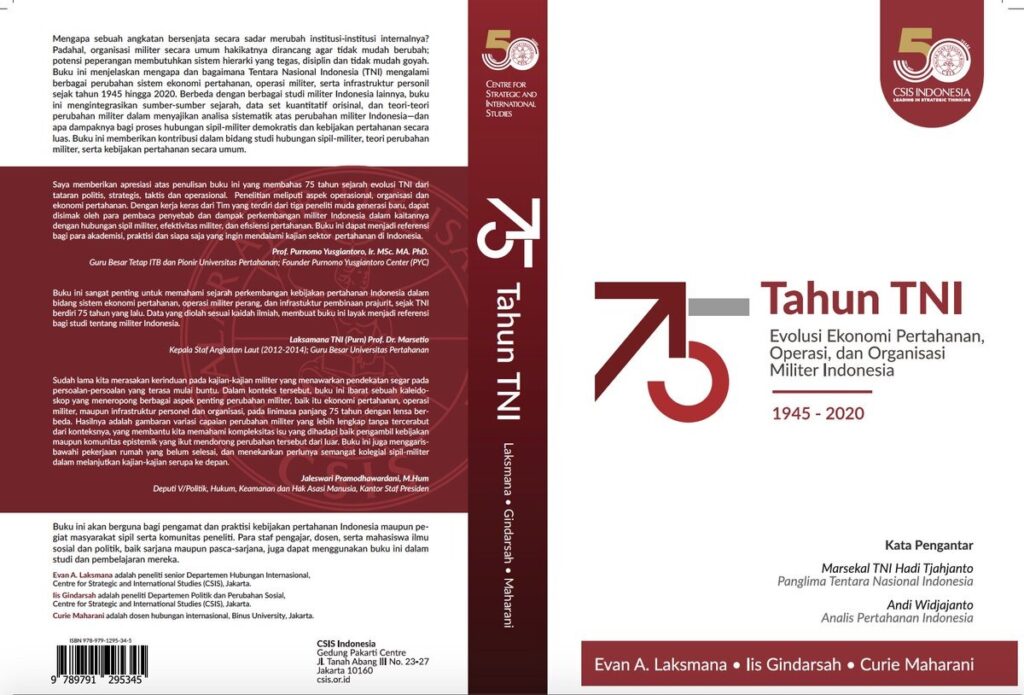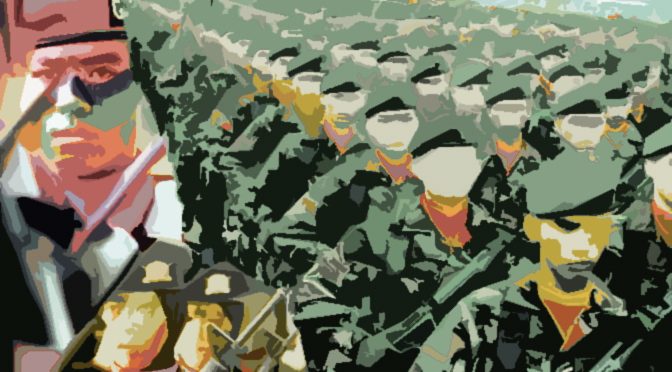Two books about Indonesia’s defence and security were published in the second half of 2020: the one reviewed here and another by Vice Admiral Agus Setiadji. The former uses a theoretical framework to explain how the TNI got to be the force it is on its 75th anniversary. The latter is a primer for people engaged in defence force development and systems acquisition. Both use their quite different starting points to make general recommendations on the future development of the TNI and national defence more broadly. Yet neither book provides a picture of the structure of the TNI today and both studiously avoid contentious political issues.
The Indonesian Armed Forces At 75 was written and published by three staff members at the Centre for Strategic and International Studies (CSIS). It uses a theory-based exploration of military change and innovation over the last 75 years to derive a framework for understanding the evolution of Indonesia’s defence economy, operations and organisation. This contrasts with the political and macro-economic focus of most histories concerned with the evolution of the TNI and is a useful addition to the literature.
The first two chapters provide a distillation of international theories on the subject. They embrace three levels of analysis—international, domestic and organisational—and within each level identify drivers or factors to analyse why the TNI has changed over the last 75 years in the absence of external threats and during periods of relative domestic peace that most other studies tend to skip over. They also take account of factors that influence the development of post-colonial militaries to explain why the TNI has invariably played a much larger role in domestic politics and security than the militaries of more mature states.
Ultimately, they deduce that the guiding light of military change for Indonesian political and military leaders has been the “institutionalisation of change”: embracing the bureaucratisation of planning and budgeting, as well as the professionalisation of the officer corps to limit their political influence.
 The third chapter on defence economy reaches the rather obvious conclusions that the defence budget has benefitted from economic growth, but its share of the government budget has shrunk from a high of 47% in 1962 to around 5%. The chapter argues that acquisition processes have been under constant change without necessarily improving effectiveness or efficiency, and remain far from systematic. Moreover, while self-funding has been greatly reduced since the transition to democracy in 1999, the Ministry of Defence still lacks expertise and has still not been civilianised.
The third chapter on defence economy reaches the rather obvious conclusions that the defence budget has benefitted from economic growth, but its share of the government budget has shrunk from a high of 47% in 1962 to around 5%. The chapter argues that acquisition processes have been under constant change without necessarily improving effectiveness or efficiency, and remain far from systematic. Moreover, while self-funding has been greatly reduced since the transition to democracy in 1999, the Ministry of Defence still lacks expertise and has still not been civilianised.
The prime strength of the book is that the authors made a concerted effort to collect as many primary sources as possible, but they did not obtain enough data to measure the difference between inputs (plans and processes) and outcomes (actual acquisitions and expenditure.) This challenge was compounded by a difference in planning and financial years until they were harmonised in 2001.
Chapter 4 covers operations, calculating that the TNI has been involved in 370 operations since 1945. Most of those have been internal with the Army as the predominant participant. The chapter is largely an enumeration of the major conflicts as well as parties and forces involved from 1945 to the present day. This is a useful resource and could provide the basis for further development but is mostly unremarkable except for some contentious claims.
For example, the authors argue that the TNI’s infiltration of Yogyakarta on 1 March 1949 was the “decisive battle” of the Revolution against the Dutch (Indonesia’s Dien Bien Phu moment.) However, the Dutch government had already concluded that the game was up shortly after the Second Police Action of 19 December 1948 failed to cower neither the Republic nor the TNI. However, it is true that this symbolic but minor action along with continued guerrilla operations and international condemnation kept the pressure on the Dutch to finalise the agreement to transfer sovereignty.
This example does not detract from the central purpose or conclusions of the study, but it is an example of the continuing currency of New Order history and the TNI’s reluctance to see that history revised. One typographic error that cannot be ignored occurred on page 266 where it is noted that 88,471 troops were employed in the capture of Dili in December 1975. The actual figure was about 11,200. This and other issues will be addressed in the English translation due out in mid-2021.
Chapter 5 explores organisational and personnel matters. It is here that history, politics and the search for the institutionalisation of change really come to the fore. Much is made of the current problem of surplus generals and colonels and how that has led to the creation of additional organisations, presumably unrelated to requirements or of low priority, and gross rank inflation across all organisations. Some of this is obvious and some contentious but it highlights again the problem of a lack of detailed primary sources. This leads to a focus on the graduates of the military academies and the rigid promotion and retention policies that feed the surplus. However, the solution to such problems needs a much broader study of why the TNI has such policies and what the alternative options are.
Nevertheless, this leads to the most compelling observation of the book—that if civil society and the political elite want to restart military reform that stalled in the mid-2000s, they must attend to the personnel needs of the TNI and the interests of the personnel it employs. The key unanswered political question is: why has civil society and the political elite been unwilling or unable to reboot military reform? Until that happens, organisational matters that should ideally precede personnel considerations cannot be finalised. The last chapter draws the three central chapters and the analytical framework together to make several pages of recommendations for reforms that, while worthy of consideration, owe little to the theory.
The authors set themselves an impossible task beginning this work in January 2020 with a publication deadline of 5 October 2020. COVID-19 only amplified the challenge, so the authors end the book with a list of matters that need further exploration, including their inability to track down many of the primary sources they sought within this tight timeframe and the absence of any significant coverage of the Navy or Air Force. Nevertheless, they have begun a journey that should be continued and supported by the Ministry of Defence and the TNI. And, who knows, perhaps even Indonesia’s historians will be freed from their shackles and allowed and encouraged to contribute to a more balanced and objective understanding of the last 75 years.
 Facebook
Facebook  Twitter
Twitter  Soundcloud
Soundcloud  Youtube
Youtube  Rss
Rss 